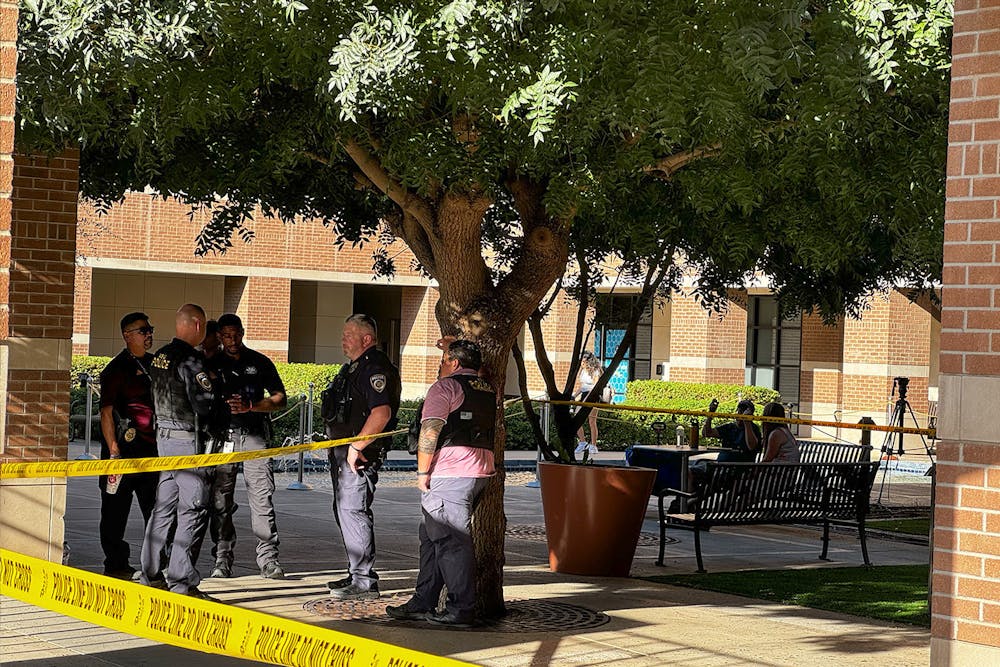Lindsey Stevens was leaving class at the West Valley campus when she saw a classroom taped off and surrounded by police on Thursday, Sept. 20. Stevens, a senior studying social justice and human rights, said she had not received any alerts or notifications from the school, nor had any faculty told her a student was stabbed in the Sands Classroom Building that day at approximately 11:45 a.m.
READ MORE: ASU student faces charges of first degree attempted murder for alleged stabbing
"Our West campus is a pretty small campus, and I hadn't received any alerts on my device, and I have all of the alert applications downloaded," Stevens said. "I went up to a group of girls, and I asked them what had happened, and they had told me someone had been stabbed. And then before I knew it, they had walked away, and I was just kind of left there."
Stevens proceeded to contact faculty members, who either did not know or could not provide details about what happened. She said the first formal piece of information she read was from The State Press Instagram feed, where a post was made about the breaking news story at 3:21 p.m.
Safety alert systems at ASU
Like Stevens, many on-campus community members are accustomed to receiving safety alerts from ASU, which "may be sent using text, email, push notification via smartphones and social media," according to the University website.
"Alerts are sent to warn the campus community at large of an ongoing, life-threatening situation," said a University spokesperson in an email. "Everyone with an ASU email account will receive alerts. The incident at the West Valley campus was over within minutes, and the suspect immediately detained and arrested, so there was no ongoing threat to the campus."
Sofie Call, a sophomore studying nursing, was in a lab when rumors began to circulate about what had happened after her friend received a text about the incident.
"We didn't know if it was just a joke because we hadn't looked it up yet," Call said. "Then when we were reading about it, we were shocked, because my friend and I had just finished a class in that area around the time that it happened."
Geofence advisories
Stevens brought her concerns to the attention of West Valley Dean of Students Regina Matos, who set up a meeting with her regarding the incident. During the meeting, Stevens said she learned that some students received a notification from the LiveSafe mobile app based on their location.
"A geofenced 'advisory' did go out to people in that part of campus, directing them to avoid the area as first responders treated the victim and detectives gathered and interviewed witnesses," a University spokesperson said in an email.
The University classifies advisories as communications about primarily non-life-threatening situations that may impact the community. That is in contrast with alerts, the term used for communications about potentially life-threatening situations. Advisories may be sent out through a variety of communication channels, including the LiveSafe app.
"The LiveSafe app is required to receive geofenced advisories, and users must ensure location is enabled on their phones, along with allowing notifications," the University spokesperson said.
ASU parent Isabel Alexander heard about the incident from her daughter, who studies nursing at the West Valley campus. Alexander said her daughter's roommate was in a classroom close to the stabbing at the time of the incident, where the students heard yelling and screaming through the walls.
Neither her daughter, nor her daughter's roommate, received an alert or an advisory while on campus that day, and "nobody knew what exactly had happened," Alexander said.
The Clery Act and alerts
ASU police is responsible for issuing campus safety alerts. According to the University website, these alerts bring heightened safety awareness to University students, faculty and staff by notifying them of crimes that pose an ongoing threat to the campus community.
According to the Clery Center, "The Clery Act requires colleges and universities to report campus crime data, support victims of violence, and publicly outline the policies and procedures they have put into place to improve campus safety."
ASU police consider whether a safety alert is necessary on a case-by-case basis, considering factors such as if the suspect has been apprehended, according to the website.
"Clery reports specifying all clear and those all clear reports come when an incident has been handled," Stevens said. "And so I thought it was interesting that (those alerts) seemed not to be an option that they chose, even though that option is there not to panic students."
LEARN MORE: State Press Play: ASU Campus Safety Issues
Following up
Call said when she thinks back to safety alerts she's received about crimes on other campuses, it usually mentions police are still looking for a suspect, so it is not "surprising" an alert was not sent out in this circumstance.
"But I still thought they would have at least said that the incident happened instead of just putting it on the news," Call said.
Alexander said as an out-of-state parent who frequently receives a variety of emails from ASU and is registered through the parent portal, she expects more safety and transparency.
Neither Call nor Alexander have received any communication or emails from the University since Sept. 20. Besides her meeting with the dean, Stevens has not either.
"Even with the lack of follow-up to discuss this event with the student body, it shows that the University administration has a hard time seeing when their students are hurting, emotionally and psychologically," Stevens said.
Edited by Senna James, Sophia Ramirez, Tiya Talwar, Alexis Heichman and Madeline Schmitke.
Reach the reporter at spbracci@asu.edu and follow @SophiaBraccio on X.
Like The State Press on Facebook and follow @statepress on X.
Sophia is a sophomore studying journalism and mass communication. This is her third semester with The State Press. She has also worked at Nomads with Notebooks and Blaze Radio.




